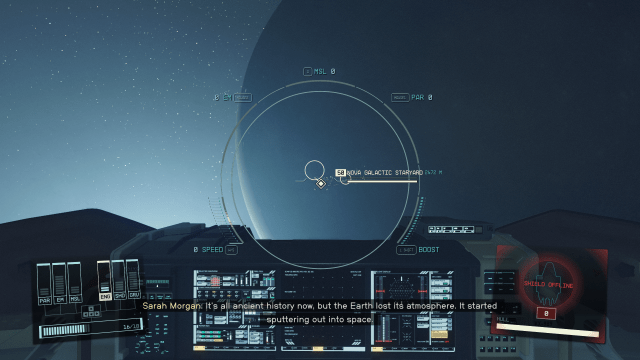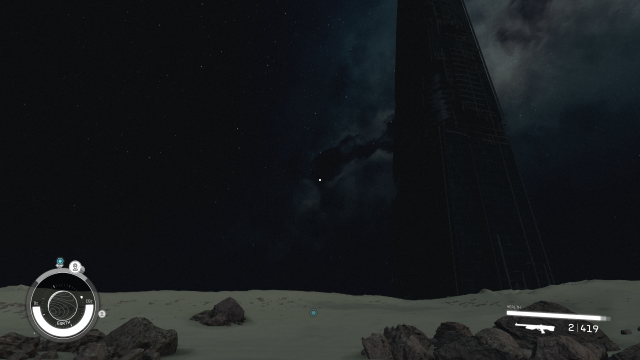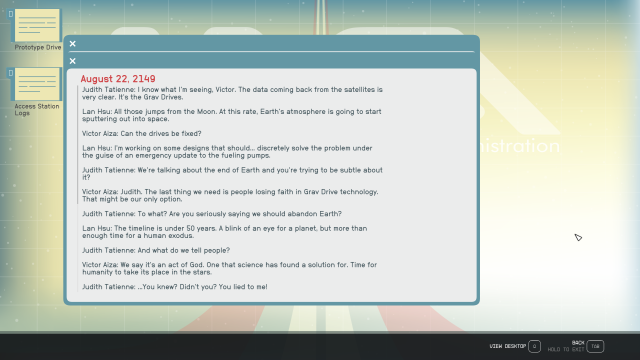Early in Starfield, you will realize that the main hubs of humanity are scattered amongst nearby systems as opposed to on Earth itself. Several stations exist orbiting planets in the Sol system but the system is rather empty for the most part. If you look at Earth you’ll notice it’s not quite the Earth we know today. Instead of a big blue and green marble, it’s a brown rocky planet. The temperature indicates it is cold, and the atmosphere is a thin layer of CO2. Also, there’s no fauna, and no flora detected on Earth. Clearly, something happened. So, what happened to Earth in Starfield?

Why is Earth uninhabitable in Starfield?
UPDATE 9/4/23: We’ve added more information at the bottom of this article that explains what exactly happened to Earth.
In an early Constellation mission in Starfield, you will visit the Sol system to try and track down someone who may have an Artifact. Constellation leader Sarah Morgan should be your companion at this time and will talk a bit about the planet’s fate.
“It’s all ancient history now, but the Earth lost its atmosphere. It started sputtering out into space,” Sarah will tell you when exploring the Sol system. “Humanity had about fifty years to evacuate the planet. That’s kind of how the United Colonies government started. Managing the exodus. Earth is more or less a dust ball now. You can occasionally find a few remnants of the world we left behind on the surface, but not much.”
So in summary, Earth has lost its atmosphere before our current place in time in Starfield. If we compare it to the real world, scientists believe that’s exactly what happened to Mars. That explains why Earth also looks a bit like Mars as we know it today. A dusty rock with no life.

Can you still visit Earth in Starfield?
Now that you know what happened to Earth in Starfield, you may want to visit it to see what it looks like in its current state. Thankfully, you can in fact still visit Earth in Starfield. In fact, one of the marked locations that you can land at is the London landmark. Upon landing here you will see the remnants of the tallest building in London, The Shard, stretching into the sky.
Even though there’s not really much here to do, if you check one of the nearby rocks you will find a surprise. A London Snow Globe. I haven’t found any specific purpose for it yet, but it is interesting that this is all we have left from Earth. Unfortunately, it’s only valued at 195 credits, so it’s not going to get you rich or anything. Maybe it will look nice on your desk in an outpost you have built to call home.
That’s pretty much all there is to find on the now desolate Earth. Before you leave, take a minute to look up and enjoy the view of the Milky Way galaxy now that there is no light pollution.
LATE-GAME SPOILERS FOR Starfield BELOW.

How did Earth lose its atmosphere in Starfield?
In one of the final story missions, you will head to Earth’s moon to get some answers. Once there you will discover an old outpost by a company called Nova Galactic. Apparently, Nova Galactic partnered with NASA to test out some new technology.
As it would turn out, this new technology was actually an Artifact found by Doctor Victor Aiza. Dr. Aiza was able to use the Artifact to create the first-ever prototype Grav Drive that ships in Starfield use to cover vast distances in a matter of minutes. In a series of logs that can be found on various computers inside a derelict NASA outpost on Earth, you start to uncover more secrets about what happened to Earth.
It turns out that the early prototypes of Earth were actually messing with Earth’s magnetosphere. More specifically, large gravity wave spikes were shot off from Grav Drive tests near the Moon in orbit. It appears those waves over time affected Earth’s magnetic shield and inner core. This led to Earth’s atmosphere eventually sputtering into space due to no magnetic shield to keep it intact.
Even though Dr. Aiza noticed this happening, he made the decision to instead worry about enhancing Grav Drive technology and using it to help evacuate Earth in the 50 years it had left before it would have no atmosphere. According to Dr. Aiza, once the issue was discovered, Earth only had 50 years. Which, to him, was a blink of an eye for a planet, but more than enough time for a human exodus to be carried out.













Published: Sep 5, 2023 3:30 AM UTC